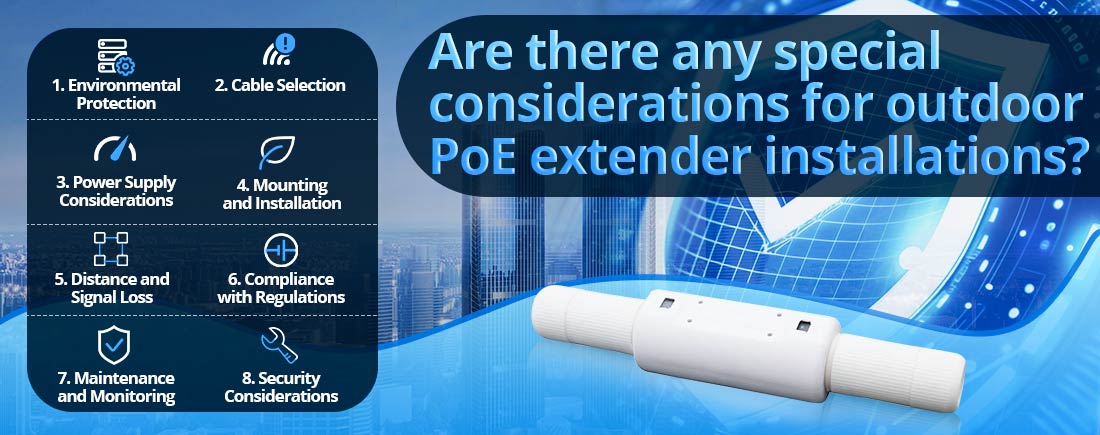
Особые соображения при установке наружного удлинителя PoE
Наружная установка удлинителей Power over Ethernet (PoE) требует тщательного планирования и использования специализированного оборудования для обеспечения надежной работы и долговечности в различных условиях окружающей среды. Ниже приведены ключевые соображения:
1. Охрана окружающей среды
--- Всепогодный дизайн: используйте PoE расширители специально разработан для использования на открытом воздухе. Ищите устройства со степенью защиты IP65 или выше для защиты от воды, пыли и мусора.
--- Диапазон температур: убедитесь, что удлинитель может работать в ожидаемом диапазоне температур места установки. Многие удлинители PoE для наружного применения поддерживают широкий диапазон рабочих температур (например, от -40°C до 75°C).
--- Устойчивость к ультрафиолетовому излучению: при воздействии прямых солнечных лучей корпус должен быть изготовлен из материалов, устойчивых к ультрафиолетовому излучению, чтобы предотвратить разрушение с течением времени.
2. Выбор кабеля
--- Кабели Ethernet для использования вне помещений: используйте кабели Ethernet, устойчивые к атмосферным воздействиям, устойчивые к ультрафиолетовому излучению и с изоляцией, способной противостоять влаге и колебаниям температуры. Примеры включают кабели, предназначенные для прямого захоронения, или кабели с полиэтиленовой (ПЭ) оболочкой.
--- Экранирование (STP). В зонах, подверженных электромагнитным помехам (EMI), или там, где кабели проходят рядом с линиями электропередачи, используйте кабели экранированной витой пары (STP), чтобы обеспечить стабильную передачу данных.
--- Заземление. Для экранированных кабелей необходимо надлежащее заземление во избежание опасности поражения электрическим током и повышения производительности.
3. Вопросы электропитания
--- Адекватный бюджет мощности: убедитесь, что источник PoE (инжектор или коммутатор) может обеспечить достаточную мощность как для расширителя, так и для подключенных устройств, учитывая потери мощности при длинных кабелях.
--- Защита от перенапряжения: используйте удлинители PoE со встроенной защитой от перенапряжения или установите внешние устройства защиты от перенапряжения для защиты от скачков напряжения, вызванных молнией или скачками напряжения.
4. Монтаж и установка
--- Надежный монтаж: закрепите удлинитель на прочной, устойчивой к вибрации поверхности с помощью кронштейнов, предназначенных для установки на открытом воздухе. Убедитесь, что устройство правильно выровнено, чтобы предотвратить нагрузку на кабели.
--- Прокладка кабелей: используйте защищенный от атмосферных воздействий кабелепровод или кабельные зажимы для организации и защиты кабелей, снижая риск их повреждения ветром, животными или вмешательством человека.
--- Точки проникновения: загерметизируйте все места проникновения кабелей, чтобы предотвратить попадание воды или мусора в устройство.
5. Расстояние и потеря сигнала
--- Длина кабеля: убедитесь, что общая длина кабеля, включая дополнительный диапазон повторителя, не превышает максимум, поддерживаемый вашей настройкой PoE (обычно 100 метров на сегмент).
--- Несколько удлинителей: для больших расстояний может потребоваться последовательное подключение нескольких удлинителей или использование промежуточных PoE-переключатели обеспечивая при этом достаточную мощность и целостность сигнала.
6. Соблюдение правил
--- Местные стандарты: убедитесь, что установка соответствует местным правилам электробезопасности и безопасности, особенно при прокладке кабелей под землей или на общественной территории.
--- Стандарты ЭМС и безопасности: убедитесь, что все устройства соответствуют электромагнитной совместимости (ЭМС) и сертификатам безопасности, необходимым для наружной установки.
7. Техническое обслуживание и мониторинг
--- Периодические проверки: регулярно проверяйте удлинитель и кабели на наличие признаков износа, коррозии или повреждений, вызванных факторами окружающей среды.
--- Удаленный мониторинг. Для критически важных приложений рассмотрите возможность использования удлинителей PoE с возможностью удаленного мониторинга, позволяющих проверять состояние и производительность устройства без проверки вручную.
8. Вопросы безопасности
--- Физическая безопасность: установите удлинитель в безопасном месте или в запираемом корпусе, чтобы предотвратить кражу или вандализм.
--- Сетевая безопасность: используйте шифрование и безопасные протоколы для защиты данных, передаваемых по сети.
Заключение
Для установки наружного удлинителя PoE требуется прочное оборудование, правильный выбор кабеля и внимание к факторам окружающей среды и безопасности для обеспечения надежной работы. Учитывая эти соображения, вы можете создать надежную и долговечную сеть PoE, подходящую для наружных приложений, таких как камеры наблюдения, точки доступа Wi-Fi и устройства IoT.